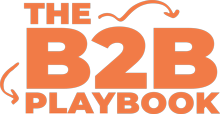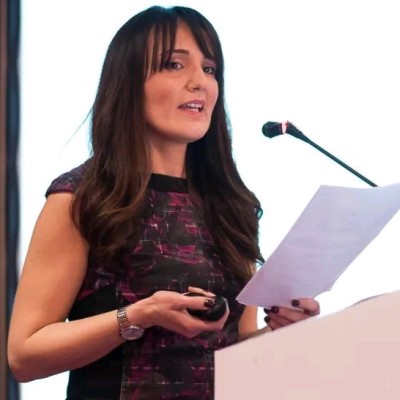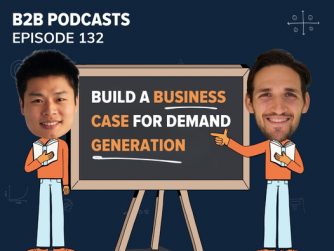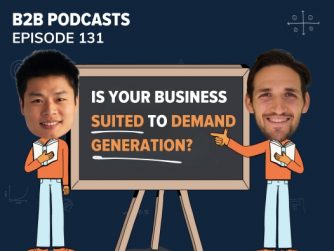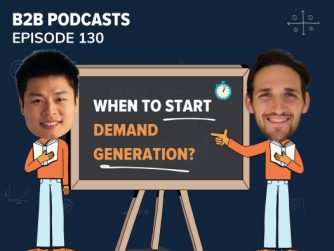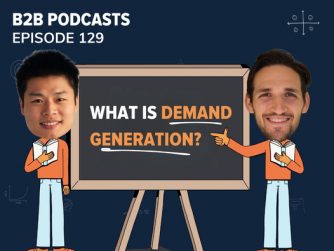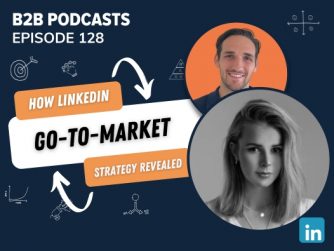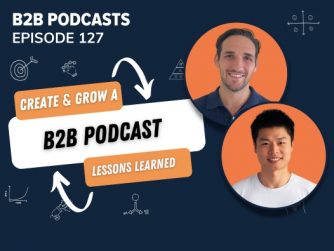In the constant battle for marketers to prove their worth to their Executive overlords, there has been an adoption of one key metric to show that marketing is having an impact.
And that metric is marketing sourced pipeline.
I’ve seen it as a key KPI in organisations both large and small. And I’m going to give you three reasons why you should think twice before using it as a KPI for marketers, and three alternatives to start reporting on.
But before I do that, let’s define marketing sourced pipeline to make sure we’re all on the same page.
Definitions: What Is Marketing Sourced Pipeline?
Marketing sourced pipeline is pipeline (i.e. leads) that have been generated by marketing efforts, and then handed off to the sales team for further nurturing and qualification.
Basically, if that lead was generated by a marketing effort as the first point of contact, then that lead would be determined ‘marketing sourced’.
Think: collecting emails at events, running lead generation activity with webinars and ebooks, capturing the details of someone who comes to your website through Google Ads.
Anything that enters your CRM that marketing can go: “Hey! That was from our marketing stuff” – that’s marketing sourced.
3 Reasons I Don’t Like Marketing Sourced Pipeline
As a marketer, I don’t really like reporting on marketing sourced pipeline as a key KPI for 3 main reasons:
- It encourages marketers to focus on ‘lead gen’ to the detriment of the business
- It puts marketing and sales at odds with each other
- It doesn’t acknowledge the complex reality of the B2B buying journey
Reason 1: Marketing Sourced Pipeline Encourages A Focus On Lead Generation
Marketers that are measured on marketing sourced pipeline are often encouraged and rewarded for bringing in as many ‘leads’ as possible. Afterall – we want to show that marketing is filling up the pipeline with leads that we sourced!
So here’s what happens: we marketers try and source as many emails and contact details as we can, collecting them through gated content like ebooks and webinars, or emails collected at events.
That means we optimise all of our activities and budgets to collecting leads. And the focus becomes quantity over quality.
Let me show you why this focus on quantity over quality becomes a problem. Check out this diagram below, showing the journey from Lead to Customer.

Sure there’s a few steps missing, like the point at which the lead becomes a MQL (Marketing Qualified Lead) and then SQL (Sales Qualified Lead), but it illustrates an important point. Despite starting with 500 leads generated by marketing, only 1% converted to an opportunity. And of those opportunities, 20% became customers – resulting in 1 new customer.
This is a grossly inefficient process for acquiring new customers, and unfortunately isn’t unusual when marketing teams are incentivised to generate as many leads as possible. What this diagram doesn’t show is the manual labour associated with the sales team calling to qualify these leads and turn them into opportunities. This is a huge expense for the business that can be overlooked as an expense related to marketing, particularly in earlier stage businesses.
When the business finally evaluates how profitable the entire acquisition process is (from lead to customer), taking into account sales’ time to service marketing’s leads, they see that it’s not hitting their CAC target (cost per acquisition). This then results in one of two scenarios:
- Scenario 1: they respond by asking marketing to increase the number of leads, and lower the cost of acquiring the leads (CPL)
- Scenario 2: they tell marketing that they need to start generating better leads
I’ve lived out both scenarios personally, and let me tell you – neither are fun.
That means we optimise all of our activities and budgets to collecting leads. And the focus becomes quantity over quality.
Increasing lead volume and reducing the CPL in a short space of time is not only extremely difficult without a significant increase in brand power, but it still won’t solve the problem of sales having to waste their time on these junk leads.
Asking marketing to produce better leads requires stakeholder management. Because – yes – we can optimise for better leads, but the result is there will be fewer of them. That means less leads for sales to call, and possibly some sales staff out of a job. This is a difficult conversation to have, and a tough situation to manage as stakeholders and sales staff freak out when lead numbers start dropping.
And this is all the result of a business measuring marketing based on how many marketing sourced leads they bring in.
Reason 2: Marketing Sourced Pipeline Makes Sales & Marketing Fight
Alignment of marketing and sales is the holy grail. But measuring marketers on marketing sourced pipeline isn’t going to help us find it.
When marketers are optimised to send stacks of leads to sales, the focus on quantity over quality often results in frustration as sales are forced to find the needle in the haystack. Cold calling people who don’t want to speak to you for hours on end isn’t a great feeling when you’re heavily incentivised by commission.
It also creates opposition between marketing and sales. For example, let’s say the biggest customer last year entered your CRM by downloading an ebook. That’s marketing sourced.
But when sales called them, they didn’t even remember downloading the ebook, let alone know who your company is or what it does. Over the course of 6 months, before they became a customer they were courted with outreach from sales, and consumed the helpful content created by marketing. Finally when budget, timing and the business case is right – sales get them across the line as a customer.
The CRM says that marketing was responsible for getting this customer. I’m not so sure sales would agree.
Reason 3: Buying Journeys Are Complex
Buying journeys are complex. We wish the journey was as simple as:
Customer downloads ebook —> Sales speaks to customer —> Sales wins customer
But it’s not. It looks a bit more like this:

The buyer needs a lot of education, needs to wrangle a bunch of different stakeholders, and has to care about the problem enough to work towards a solution. But when we optimise for marketing sourced pipeline, marketing can effectively say their job is done at the point where a prospect downloads our ebook and we get their contact details.
Rather, there should be continuous education from marketing past that point that enables the buyer to self-educate, until they are ready to talk to sales. Even while talking to sales, marketing still needs to be doing the legwork to support sales and stay top of mind, to show the match between the product and their pain points.
Marketing should also be thinking beyond the sale, continuing to help expand, upsell, and cross-sell to existing accounts.
Marketing sourced pipeline as a KPI just doesn’t encourage marketers to do that.
The One Exception: Website Sourced Pipeline
There is one measurement of pipeline I don’t mind. That’s high-intent, website sourced pipeline. This is pipeline from prospects who fill out a high-intent form on your website, like a ‘Request A Demo’ form. However I only think it’s fair to measure this when the product less complex and is of relatively low value (< $15,000). The rationale behind this is that marketing should be able to do all of the education without sales, and get a prospect to request a demo.
However when the product is complex and higher value, naturally there’ll need to be some more 1:1 involvement between your business and the prospect – and that’s normally where sales comes in.
So How Should We Measure Our Marketers?
One alternative to marketing sourced pipeline adopted by more mature marketing teams is marketing influenced pipeline.
Rather than looking at where the pipeline originated from (e.g. sales or marketing), it looks at whether marketing ‘touched’ the prospect (e.g. consuming content, attending events etc.), to help usher them through the pipeline.
This has its own host of issues, but at least recognises the complexity of B2B Marketing and that marketing and sales need to work together as one revenue team.
A Framework To Measure B2B Marketing Performance
I suggest that B2B Marketers should adopt a 3 tiered reporting framework that:
- Demonstrates marketing is having a positive impact on the business
- At minimum is aligned with sales and is buildinging trust and affinity with those in your ICP (Ideal Customer Profile)
These are the 3 tiers:
- Tier 1: Website sourced pipeline and revenue
- Tier 2: Qualitative and quantitative insights indicating business results
- Tier 3: Channel level KPIs indicating you’re making an impact with your ICP in your target segments
We detail these 3 tiers you should use to measure demand generation and its KPIs here. But I normally suggest B2B marketers start with Tier 3, and as they make inroads eventually report on Tiers 2 and 1.
For now, if your marketing function is being judged based on the marketing sourced pipeline it’s bringing in, please evaluate if it’s having any of the negative effects discussed in this article.
Check out Episode 72 of The B2B Playbook podcast where we go through each of the 3 Tiers of B2B demand gen reporting in detail!
Strategy, Templates & Tools To Drive More Revenue With Marketing
Our 5 BEs Framework teaches b2b marketers exactly how to drive more revenue with your marketing.
We share our Framework step-by-step every week on The B2B Playbook.
There’s 3 ways you can learn and implement it in your own business:
- Listen to The B2B Playbook Podcast
- Subscribe to our Newsletter
- Apply for The B2B Incubator
(P.S. The B2B Incubator gives you strategy, templates and tools you need to implement this in your business over 12 weeks. Click here to find out more or apply now).


